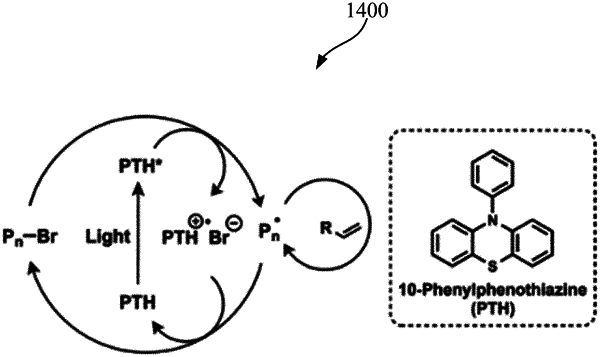| CPC G03H 1/02 (2013.01) [C08F 2/48 (2013.01); C08F 20/18 (2013.01); C08L 75/04 (2013.01); C08F 2438/01 (2013.01); C08F 2438/03 (2013.01); G03H 2001/0264 (2013.01)] | 14 Claims |

|
1. An optical recording film for holographic recording comprising:
a first substrate;
a second substrate;
a polymer matrix between the first substrate and the second substrate and characterized by a first refractive index;
monomers dispersed in the polymer matrix and characterized by a second refractive index different from the first refractive index, the monomers configured to polymerize in regions of the optical recording film exposed to recording light;
an initiator including an alkyl halide dispersed in the polymer matrix;
a photoredox catalyst for controlled radical polymerization of the monomers during exposure to the recording light, the photoredox catalyst dispersed in the polymer matrix and including a metal-free organic photocatalyst, wherein the photoredox catalyst is sensitive to visible light and is reversible, and wherein an amount of the photoredox catalyst is selected such that the photoredox catalyst is configured to, upon exposure to the visible light in selected regions of the optical recording film,
generate, from the alkyl halide and in the selected regions of the optical recording film, an alkyl radical for initiating polymerization of the monomers; and
generate, from the photoredox catalyst and the alkyl halide and in the selected regions of the optical recording film, a sufficient amount of deactivating catalyst complex for suppressing the polymerization of the monomers in the selected regions of the optical recording film during and after the exposure to the visible light, such that a polydispersity index of polymers formed by the polymerization of the monomers in the selected regions of the optical recording film is controlled by the photoredox catalyst, wherein the deactivating catalyst complex includes a radical cation of the photoredox catalyst and a halide anion and is configured to, during and after the exposure of the selected regions of the optical recording film to the visible light, reduce the radical cation of the photoredox catalyst in the selected regions back to the photoredox catalyst and deactivate carbon-centered propagating radicals in the selected regions using the halide anion to form halogen end-capped polymer chains and suppress the polymerization; and
a deactivator before the exposure to the recording light, wherein the deactivator includes the deactivating catalyst complex and is characterized by a concentration about 10% of a concentration of the photoredox catalyst before the exposure to the recording light.
|